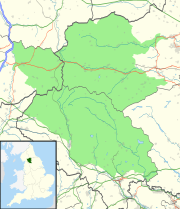| Notts Pot | |
|---|---|
 A caver descending a 25-metre (82 ft) shaft in Notts Pot | |
| Location | Leck Fell, Lancashire, England |
| OS grid | SD 6710 7780 |
| Coordinates | 54°11′42″N 2°30′20″W / 54.1949°N 2.505656°W |
| Depth | 157 metres (515 ft) |
| Length | 5,200 metres (17,100 ft) |
| Discovery | 1946 |
| Geology | Carboniferous limestone |
| Entrances | 4 |
| Hazards | verticality, water |
| Access | CNCC Permit |
| Cave survey | cavemaps |
Notts Pot is a cave on Leck Fell, in Lancashire, England. Its entrance is a 10-metre (33 ft) deep shaft. It is part of the Three Counties System, an 87 kilometres (54 mi) cave system which spans the borders of Cumbria, Lancashire, and North Yorkshire.[1]
Description edit
The entrance shaft descends some 50 metres (160 ft), and the way on is through the water descending from Rumbling Beck Cave above into a fault passage. Four further pitches descend into a chamber to a low canal passage. Upstream gets too low after some 60 metres, but downstream has been forced round some awkward bends and through some ducks into Rumbling Hole Inlet in Lost Johns' Cave. This section of cave is about 250 metres (820 ft) long.[2]
An alternative route begins from a passage entered a few metres below the west end of the entrance shaft. These passages are, in the main, tighter and more complex than the main route, but the main passage descends an alternative set of pitches to a sump which is believed to be the upstream sump of the inlet canal at the end of the main route. This set of passages, known as the Dead Dobbin Series is about 350 metres (1,150 ft) long.[3]
Rumbling Beck Cave is the source of the water which enters the entrance shaft 8 metres (26 ft) below the surface at the east end. The normal entrance is where the stream sinks 50 metres (160 ft) east of the Rumbling Hole. The main passage starts off as a crawl, but develops into a trench before reaching the shaft. A roof passage starting some 20 metres (66 ft) from the end leads to an alternative window in the shaft. Rumbling Beck Cave is about 100 metres (330 ft) long.[2]
Geology and Hydrology edit
The cave is a solutional cave formed in Visean Great Scar limestone from the Mississippian Series of the Carboniferous period. Its development has been largely determined by the same vertical fault that may be observed in the nearby Death's Head Hole and Big Meanie. The stream which flows through the cave enters Lost Johns' Cave as a tributary, and eventually emerges from the Leck Beck Head spring in Ease Gill.[4] It is thought that the current hydrology is relatively recent, and that some 350,000 years ago Rumbling Hole was a major sink that took water into now-blocked passages at the north end of the shaft, through East Passage and West Passage in Death's Head Hole and the passages associated with Glasfurds Chamber in Gavel Pot, and hence to a resurgence in the Leck Beck valley some 100 metres (330 ft) above the current resurgence which is now covered with glacial till.[5]
History edit
The entrance of Notts Pot was found in early 1946 by P. M. Stott, of the Nottingham University Mountaineering Club, hence the name. A recent collapse in a shakehole had opened up a 14-metre (46 ft) shaft into the stream passage. The main passages in the cave were explored in the March of that year by members of the British Speleological Association.[6] Adamson's Route, the fourth way down the system, and Acrobat Pot were explored by the University of Leeds Speleological Association in 1967.[7] The Far Chamber Series and De Profundis together with associated passages were explored by Lancaster University Speleological Society in 1969 and 1970.[8] In March 1983 The Crave Pothole Club dug through the boulder choke at the end of the Far Chamber Series to enter Hangingwater Hall, but the dig collapsed soon after, and has yet to be re-entered.[9]
The inlet sump near the bottom of Notts I was connected to Ireby Fell Cavern by diving by Phil Papard in 1976.[10]
References edit
- ^ Allen, Tim (Feb–Mar 2012). "The True Length Unravelled". Descent (224): 24–25.
- ^ a b Brook, Dave; Griffiths, J; Long, M.H.; Ryder, P.F. (1994). Northern Caves. Voume 3. The Three Counties System and the North-West. Dalesman Publish Company. pp. 113–114. ISBN 1855680831.
- ^ Ramsay, Dave (Feb–Mar 2008). "Rumbling Extension". Descent (200): 13.
- ^ Waltham, A.C.; Simms, M.J.; Farrant, A.R.; Goldie, H.S. (1997). Karst and Caves of Great Britain. London: Chapman & Hall. pp. 30–34. ISBN 0412788608.
- ^ Waltham, A.C. (1974). Limestone and Caves of North-West England. Newton Abbot: David & Charles. pp. 289–290. ISBN 0715361813.
- ^ Gemmel, A.; Myers, J.O. (1952). Underground Adventure. Clapham, Yorkshire: Dalesman Publishing Company. pp. 63–75.
- ^ "A Fourth Way Down Notts Pot". ULSA Review (1): 6–8, 11. 1968. Retrieved 26 January 2016.
- ^ Proctor, Alan (1971). "Notts Pot Extennsion". Lancaster University Speleological Society Journal. 1 (1): 7–9. Retrieved 26 January 2016.
- ^ Halliwell, Ric (July 1999). "Getting up north, the very slow way - Notts Pot". CRAVEN POTHOLE CLUB Record (55). Retrieved 26 January 2016.
- ^ Bedford, Bruce (August 1976). "Papard Dives to Link Notts Pot with Ireby Cavern". Descent (34): 4.
[Category:Caves of Lancashire]] [Category:Caves in the Three Counties System]]
